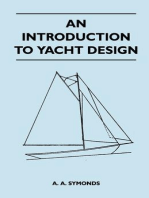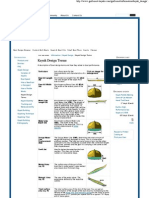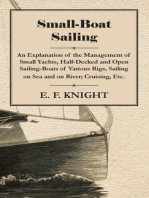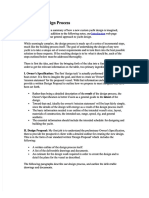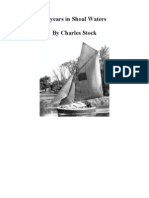Physics of Sailing
Physics of Sailing
Uploaded by
JUNIOR JAVIER OLIVO FARRERACopyright:
Available Formats
Physics of Sailing
Physics of Sailing
Uploaded by
JUNIOR JAVIER OLIVO FARRERACopyright
Available Formats
Share this document
Did you find this document useful?
Is this content inappropriate?
Copyright:
Available Formats
Physics of Sailing
Physics of Sailing
Uploaded by
JUNIOR JAVIER OLIVO FARRERACopyright:
Available Formats
The physics of sqiling
BryonD. Anderson
Sqilsond keels,likeoirplonewings,exploitBernoulli's
principle.
Aerodynomic ond hydrodynomic insighishelpdesignericreqte
fosterioilboots.
BryonAndersonis on experimentol nucleorphysicistond,choirmonof the physicsdeportmentot KentSloteUniversityin Kent,Ohio.
He is olsoon ovocotionolsoilorwho lecfuresond wrifesoboutthe intersection
behyeenphysicsond soiling.
In addition to the recreational pleasure sailing af- side and lower on the downwind side.
fords, it involves some interesting physics.Sailing starts with For downwind sailing, with the sail oriented perpen-
the force of the wind on the sails.Analyzing that interaction dicular to the wind directiory the pressure increase on the up-
yields some results not commonly known to non-sailors. It wind side is greater than the pressure decrease on the down-
turns ou! for example, that downwind is not the fastestdi- wind side. As one turns the boat more and more into the
rection for sailing. And there are aerodynamic issues.Sails direction from which the wind is coming, those differences
and keels work by providing "lift" from the fluid passing reverse, so that with the wind perpendicular to the motion of
around them. So optimizing keel and wing shapesinvolves the boat, the pressure decrease on the downwind side is
wing theory. greater than the pressure increase on the upwind side. For a
The resistance experienced by a moving sailboat in- boat sailing almost directly into the wind, the pressure de-
cludes the effects of waves, eddiei, and turb-ulencein the crease on the downwind side is much greater than the in-
water, and of the vortices produced in air by the sails.To re- crease on the upwind side.
duce resistanceeffectively by optimizing hulls, keels, and Experimenting with what can be done, a beginner finds
sails, one has to understand its various components. some surprising results. Sailors know well that the fastest
point of sail (the boat's direction of motion with respect to the
Wind power wind direction) is not directly downwind. Sailboats move
Moving air has kinetic energy that cary through its interac- fastest when the boat is moving with the wind coming
tion with the sails,be used to propel a sailboat.Like airplane "abeam" (from the side). That's easily understood: When a
wings, sails exploit Bernoulli's principle. An airplane wing is sailboat is moving directly downwind, it can never move
designed to causethe air moving over its top to move faster faster than the wind because, at the wind speed, the sails
than the air moving along its undersurface.That results in would feel no wind. In fact, a boat going downwind can
lower pressure above the wing than below it. The pressure never attain the wind speed because there's always some re-
difference generatesthe lift provided by the wing. sistance to its motion through the water.
There is much discussionof whether the pressurediffer- But when the boat is moving perpendicular to the wind,
encearisesentirely from the Bemoulli effector partly from the the boat's speed doesn't decrease the force of the wind on the
wing's impact and redirection of the air. Classicwing theory sails. One sets the sails at about 45o to the direction of mo-
attributesall the lift to the Bemoulli effectand ascribesthe dif- tion-and to the wind. The boat's equilibrium speed is de-
ferencein wind speedsaboveand below the wing to the wing's termined by the roughly constant force of the wind in the
asymmetric cross-sectionalshape,which causedthe path on sails and the resistance against the boat's motion through the
top to be longer. But it's well known that an updown sym-, water. If the resistance can be made small, the velocity can be
metrical wing can provide lift simply by moving through the large. That's seen most dramatically for sail iceboats, which
air with an upward tilf called the angle of attack. Thery de- skate on the ice with very little resistance. They can glide
spite the wing's symmetry,the wind still experiencesa longer along at speeds in excess of 150 kmlh with the wind abeam
path and thus greater speed over the top of the wing than at speeds of only 50 km/h! Of course sailboats plowing
under its bottom. A NASA websitehas an excellentdiscussion through the water experience much more resistance.
of the various contributions to lift by an airplane wing.l It dis- Nonetheless, some specially constructed sailboats have at-
putes the conventionalsimple version of wing theory and em- tained speeds of more than twice the wind speed.
phasizes that lift is produced by the tuming of the fluid flow.
The caseis similar for sailboats.A sail is almost always Keels
curved and presented to the wind at an angle of attack. It was recognized centuries ago that a sailboat needs
The situation is shown schematically in figure 1a. The something to help it move in the direction in which it's
wind moving around the "upper," or downwind, side of pointed rather than just drifting downwind. The answer was
the sail is forced to take the longer path. So the presenceof the keel. Until the development of modem wing theory it
the surrounding moving air makes it move faster than was thought that one needed a long, deep keel to prevent
the air passing along the "lower," or upwind, side of the side-slipping. But now it's understood that a keel, like a sail,
sail. Measurementsconfirm that relative to the air pressure works by providing sideways lift as the water flows around
far from the sail, the pressure is higher on the upwind it, as shown in figure 1a. A keel must be symmetrical for
38 February2008 PhysicsToday @ 2008 American Instituteof Physics,5-0031-9228-0802-020-6
"#
Fsail F.1.ng
F.,t.ng
Figurel. Forceson o movingsoilboqt.(q) Soil ond keelproducehorizontol
"|ift" forcesdue to pressuredifferences
from differentwind'ondwoter speeos,
respectively, on oppositesurfoces.(b) Thevectorsumof lift forcesfrom soil
ond keelforcesdetermines the boot'sdirectionof motion(ossuming there'sno
rudder).When boot speedond courseore constont,the net lift forceis pre-
ciselyboloncedby the velocity-dependent drog forceon the boot os it plows
throughwoter ond oir.
the sailboat to move to either side of the wind. with respect to the hull and the bulk of water farther away.
A keel works only if the motion of the boat is not exactly The shear means that van der Waals couplings between water
in the direction in which it's pointed. The boat must be mov- molecules are being broken. That costs energy and createsthe
ing somewhat sideways. In that "crabbing" motion, the keel resistive force, which becomes stronger as the boat's speed
moves through the water with an angle of attack. Just as for increases.The energy dissipation also increaseswith the total
the sails in the wind, that causes the water on the "high" area of wetted surface.
(more downstream) side of the keel to move faster and cre- Although the effect is called frictiorral resistance,it's im-
ate a lower pressure. Again, the net lift force on the keel is portant to realize that the resistive force in water is basically
due to the combination of that decreasedpressure on the high different from the frictional force between solid surfaces
side and increased pressure on the other (low) side. rubbed together. To reduce ordinary friction, one can polish
In figure 1b, the keel lift thus generated points almost in or lubricate the sliding surfaces. That makes surface bumps
the opposite direction from the lift provided by the sails. The smaller, and it substitutes the shearing of fluid lubricant mol-
two vectors can be resolved into components along and per- ecules for shearing of the more tightly bound molecules on
pendicular to the boat's direction of motion. For a saiiboat the solid surfaces.
moving in equilibrium-that is, at constant speed in a fixed For a boat moving through water, however, polishing the
direction-the transverse lift components from sail and keel hull doesn't eliminate the shearing of the molecules of water,
cancel each other. The componeni of the driving force from which is already a fluid. The resistive force cannot be reduced
the sails in the direction of motion is the force that is actually significantly except by reducing the wetted surface. It does
moving the boat forward. For equilibrium motion, that force help to have a smooth surface, but that's primarily to reduce
is balanced by the opposing component of the keel lift plus turbulence.
the total resistive force. The generation of turbulence is a general phenomenon
Wing theory, developed over the past 100 years for flight, in the flow of fluids. At sufficiently low speeds, fluid flow is
indicates that the most efficient wing is long and narrow. Vor- laminar. At higher speeds, turbulence begins. Its onset has to
tices produced at the wing tip cost energy. A long, narrow do with the shearing of the molecules in the fluid. When the
wing maximizes the ratio of lift to vortex dissipation, thus shearing reaches a critical rate, the fluid can no longer re-
providing the best performance for a given wing surface area. spond with a continuous dynamic equilibrium in the flow
That also applies to sailboat sails and keels. and the result is turbulence. Its onset is ouantifiecl in terms
It is now recognized that the most efficient keels are nar- of the Reynolds nrrmber
row from front to back and deep. Such a keel can have much
R: (Lu)l(p.lp), (1)
less surface area than the old long keels. Less area means less
resistance.Most modern racing sailboats, such as those used where zris the velocity of the flowing fluid, p is its viscosity,
in the America's Cup races, have deep, narrow keels that are p is its density, and L is the relevant length scale of the sys-
very efficient at providing the lift necessary to prevent side- tem. Rearranging factors in equation 1, one can think of R as
slipping. Of course, such keels are a problem for recreational the ratio of inertial forces (pz;)to viscous forces (p/L). In the
sailors in shallow waters. late 19th century, English engineer Osborne Reynolds found
that, with surprising universality, turbulence begins when
Resistive
forces that dimensionless parameter exceeds about a million.
A sailboat experiences several kinds of resistance.The first is For a boat of length L moving through water at velocity zr
simply the resistance of the hull moving through water. As to see when turbulence begins in the flow along the hulf R is
the boat moves, it shears the water. Water molecules adhere about 106Lu (in SI units). A typical speed for a sailboat is 5
to the hull's surface. So there must be a shear-that is, a ve- knots (2.4 m/s). At that speed, thery one should expect turbu-
locity gradient-between the adhering molecular layer at rest lence for any boat longer than half a meter. (Used worldwide
www.physicstoday.org February2008 PhysicsToday 39
-
Figure2. Vorlex formotion by the keel.
Unlessthe boot is soilingstroight
oheod, there'so pressuredifferencebe-
tweenthe tuo sidesof the keel.As o
resuh,the wqler flow onglesdown on
the high-pressure(lowerwoter-speed)
sideond up on the low-pressure side,
creotingq twist in the flow thot gener-
oles vorticesbehind the bottomreor of
Side view Front view
the keel.
as a measureof boat speed,a knot is one nautical mile per hour. grate from the high-pressure side to the low-pressure side.
A nautical mile is one arcminute of latitude, or 1.85km.) Figure 2 sketdres that effect for a keel. What actually hap-
Becauseturbulence dissipatesenergy,it increasesthe re- pens, as shown in the figure's side view, is that the flow an-
sistanceto motion through the water. With turbulence, a sail- gles a bit up on one side and down on the other. \A/henthose
boat's resistanceis typically four or five times greater than it flows meet at the back of the sail or keel the difference in
is when the flow along the hull is laminar. A rough surface their arrival angleshas a twisting effect on the fluid flow that
will causefurbulence to be greater and begin sooner.That's can causea vortex to come off the top of the sail or the bot-
the main reasonto have a smooth hull surface. tom of the keel.
Turbulencealso occurs in the air flowing along the sur- The effect is well known for airplane wings. Called in-
face of the sail. Water is a thousand times denser than air and duced drag, vortex formation costs energy.Figure 3 shows
50 times more viscous. So for the air-sail system one gets vorticesgeneratedat the tops of sailsby racing sailboatsmov-
ing through a fog. A long keel will generatevery large vor-
R=7 xt0aLa. (2)
tices.By making the keel short and deep,one can increase*re
For a typical wind speed of 5 m/s, thery one gets turbulence if ratio of lift to energy dissipated by vortices. The same is ac-
the sail is wider than about 3 meters. When turbulence forms complished-especially for sailboats racing upwind-by
in the air flow along the sail, the desired pressure difference having tall, narrow sails.It's also why gliders have long, nar-
betweenthe two sidesof the sail-its lift-is diminished. row wings.
Another important resistive force comes from vortex Becauseit's often impractical to have a short deep keel
generationat the bottom of the keel and at the top of the sails. or a narrow long wing, one c.rn install a vane at the tip to re-
When the air or water moves around the longer-path side of duce the flow from the high-pressure to the low-pressure
the sail or keel, its speedincreasesand thereforeits pressure side. On planes they're called winglets, and on keels they're
falls. As the air or water moves along the sail or keel, it will simply called wings. A modem recreationalor cruising sail-
respond to the resulting pressuredifference by trying to mi- boat will have a keel that's a compromise between the old-
Figure3. Soiliops
formvorlicesvisiblein
bg. Thebootswere
porticipoting
in the
20Ol-02 Volvo
OceonRoceoff Cope
Town,SouthAfrico.
(Photocopyrighl
DonielForsfer,used
withpermission.)
40 February2008 PhysicsToday www.physicstoday.org
Figurc4. Moving ot
hull speed,o. soilboot
generoteso bow
wove whose wove-
lengthiustequolsthe
lenothof the boo/s
woLr line. Thewove
crestsol bow ond
stern,with o single
well{ormed trough in
befween.(Photoby
Greg Green, used
with permission.)
fashioned long keels and the modem deep, narrow keels- True wind direction
with a wing at the bottom rear end to reduce induced drag.
Such keel wings were first used by the victorious sailboat
AustraliaII in the 1983America'sCup race.Modem wing the-
Close-hauling
ory also suggeststhat to minimize induced drag, keels and
sails should have elliptic or tapered trailing edges.2Such
shaped edgesare now common.
A sailboat also has a resistancecomponent due simply
to its deflection of water sidewaysasit advances.That'scalled
form resistance,and it obviously depends on hull geometry.
Close-reaching
It's easy to seethat narrow hulls provide less resistancethan
do wider hulls. Any boat will always be a compromise be- JO
tween providing low form resistanceand providing passen-
ger and cargo space.Seekingto minimize form resistancefor 800
a given hull volume, shipbuilders have tried many basichull
shapesover the centuries.Even IsaacNewton weighed in on 90o Beam-reaching
the question. He concluded that the best hull shapeis an el-
lipsoid of revolution with a truncated cone at the bow. 100'
Extensivecomputer modeling and tank testing have re-
sulted in a modern hull design that widens slowly back from
the bow and then remains fairly wide near the stem. Even
with a wide stem, designerstry to provide enough taper to-
ward the back to allow smooth flow there.That taper is often
accomplished by having the stem rise smoothly from the
water rather than by narrowing the beam. If the flow from Reaching
the stem is not smooth, large eddieswill form and contribute
to resistance.
1700
Hullspeed Running
As a boat moves through water, it createsa bow wave that Figure5. Speedspredictedby o computermodelt for
moves with the speed of the boat. Water waves are disper- o lO-meter-long cruisingsoilboot,plottedfor threediffer-
sive; long waves propagate faster than short ones.Therefore ent wind speedsfrom 6lo 20 knotsos o functionof the
the length of the full wave generatedby the bow is deter- onqle of the boot'smotion relotiveto the wind direction.
mined by the boat's speed.As a boat starts to move slowly (10-knots= 18.5 km/h.l An ongleof l80' meonsthe
through the water, one seesat first a number of wave crests boot is "runnino"with the wind directlvot its bock.The
and troughs moving down the side of the hull. As the boat fostestspeedso-repredictedwhen the toot is "beom
speedsup, the wavelength gets longer and one seesfewer reoching,"thot is, movingot obout 90" to the wind. The
waves down the side. Eventually at some speed, the wave boot evenmokessomeprogresswhen i/s "closehouling"
will be long enough so that there's just one wave down olmostdirectlyinto thewind.
the side of the boat, with its crest at the bow a trough in the
www.physicstoday.org 2008 PhysicsToday 41
February
Figure6. A hydrofoil
soilbootwith solid.
winglikesoils,moving
ot obout lwice the
wind speedwith the
wind qbeom-thot is.
blowinofrom ihe side.
(Copyiisht
Ecole
No-
tionoleSup6rieure
de
TechniquesAvonc6es.)
middle, and another crest at the stern (seefigure 4). That's at the bottom of the keel. The assortedremaining contribu-
calledthe hull speed. tions, including eddy formation behind the boat and aerial
If the boat speed increasesfurther, the wavelength in- vortex generation by the sails, provide the remaining 10 to
creasesso that the secondcrest moves back behind the boat 15%. Of course the fractional contributions vary with boat
and the stem beginsto descendinto the trough. At that point, speed,wave conditions, and the direction of motion relative
the boat is literally sailing uphill and the resistanceincreases to the wind.
dramatically.That's called wave resistance.Of course,if one
has a powerboatwith a large engine and a flat-bottomedhull, Predicting
speed
one can "gun" the engine and causethe boat to jump up on One canexploit the physicsof sailingto calculateboat speeds
the bow wave and start to plane on the water's surface.Most for a given sailboat for different wind speedsand points of
sailboatsdon't have either the power or the hull geometry to sail. Such calculations are usually performed iteratively by
plane. So they're ultimately limited by wave resistance. computer programs that start from two basic vector equa-
The wave-resistancelimit also applies to all other so- tions to be solvedsimultaneously:
called displacementboats:freighters,tankers,tugs, and most
Fdlu" = F."ri.tnn." dfld Mn""' = Mrighting'
naval vesselsbigger than PT boats-that is, any boat that e)
can't rise to plane on the surface.The functional dependence Here Fo,,u"is the total driving force in the direction of motion
of water-wave speedu on wavelength I is well known. From provided by the wind in the sails, ?hd F,",r,tu..u is the sum of
the limiting casefor deep-waterwaves for the solution of the all the resistive forces. The torques Mn"", and Mrighting are the
two-dimensional Laplace wave equation,3or from a simple heeling and righting moments caused by the wind in the sails
derivation due originally to Lord Rayleigh,a one gets, and the weight of the hull and keel.
a = l/ gX/E, where g is the accelerationof gravity. In the forrn The force of the wind on the sail is calculated as a lifting
commonly used by sailors in the US, force perpendicular to the apparent wind direction and a
drag force in the direction of the apparent wind. (The appar-
o=1.341T,, (3)
ent wind is the wind as perceived by an observer aboard the
where the i is in feet and zris in knots. moving vessel.) These lift and drag forces are then resolved
If one equatesthe wavelength to the waterline length of into components along and perpendicular to the direction of
a boat, equation 3 gives the boat's hull speed.For a sailboat motion. The net force in the direction of motion is then F0.,"",
with a waterline length of 20 feet (6 m), the hull speed is 6 and the net force perpendicular to the boat's motion is what
knots. For a large cruising sailboatwith a waterline of 40 feet produces the heeling moment. The two equations in (4) must
(12 m), it's about 8 knots. And for a 300-foot-longnaval ves- be solved simultaneously because the angle of heel affects the
sel, it's 23 knots. In practice, it's very difficult to make a dis- total driving force.
placementboat go fister than aboul 1.5times its hull speed. Following Bernoulli's principle, one takes the force of the
Combining all the components of resistancefor a sail- wind in the sails to be proportional to the total sail area times
boat moving at closeto its hull speed,one finds that the fric- the square of the apparent wind speed. The actual forces are
tional resistancecontributesabout a third of the total, and the then obtained with empirical lift and drag coefficients, given
wave resistanceanother third. Form resistanceaccountsfor as functions of sail geometry and angle of attack. Frictional
about-1,0"/o, as does the induced drag from vortex generation resistance is proportional to the hull's wetted surface area and
42 February2008 PhysicsToday www.physicstoday.org
increases as the square of the boat's speed. All the various ally represent the best compromise for overall sailing.
contributions to total resistance involve emnirical coeffi- What's the highest speed a sailboat can reach? The trick
cients. Wave and form resistance ure as functions is to reduce resistance. An iceboat can outrun the wind be-
"*p.essei
of the hull's "prismatic coefficient," whicir is an inverse meas- cause it has so little resistance. For a sailboat, the resistance
ure of the tapered slimness of its ends. comes primarily from having to plow through the water. The
There are simple and complex speed-prediction com- best way to reduce that resistance is to move less and less of
puter programs. Some that have been refined over decades the boat through the water. One answer is hydrofoils. They
for racing applications are kept private and closely guarded.
are vanes placed below the hull that raise it out of the water
Figure 5 shows the results of calculations I performed for a
as the boat speeds up.
30-foot (10-m) cruising sailboat using a publicly available
Sailboats with hydrofoils have reached speeds of more
program.s The figure shows the calculated boat speed as a
than 40 knots when the wind speed was barely half that. One
function of wind speed and point of sail. The predicted boat
such craft is shown in figure 6. These vessels are not usually
speeds are greatest when one is sailing about 90o away from
practical for cruising and other normal recreational activities.
the wind direction. Sailors call that beam reaching. It yields
They're sometimes dismissed as low-flying aircraft. A more
a boat speed of about half the wind speed.
Such calculations are confirmed experimentallv, with a practical altemative is the catamaran-a double-hulled sail-
degree of accuracy that depends on the iophistication of the boat. Catamarans are being developed to provide relatively
model and on how much the program has been funed for a stable, fast sailing. Although they are more expensive than
specific kind of sailboat. Broadly speaking, a sailboat is faster traditional single-hull sailboats for a given amount of living
if it is longer and narrower, with bigger sails and a smaller space, catamarans are becoming increasingly popular.
wetted surface. Such general rules can, of course, yield a boat
that's longer than one wants, or tips over too easily, or has too References
little room inside. 1. "What ls LiIt?" at http://www.grc.nasa.gov/WWWIK-1.21
So every design feafure is a compromise between com- airplane/lift1.html.
peting needs. For sailing downwind, one wants fairly square 2. A. M. Kuethe, C.-Y. Chow, Foundationsof Aerodynamics:Basesof
AerodynamicDesign,3rd ed., Wiley, New York (7976),chap.6.
sails, which are best at catching the wind. But for sailing up-
3. W C. Elmore, M. A. Heald, Physicsof Waaes,Dover, New York
wind, tallet narrower sails are best, because they maximize
(1969),chap.6.
the ratio of lift to energy lost by generating vortices. The most 4. B. D. Andersory ThePhysicsof SailingExplained,Sheridan House,
efficient keel is deep and narrow, to maximize lift with min- Dobbs Ferry NY (2003).
imal surface area. But a deep keel is problematic in shallow 5. D. E. Martiry R. F. Beck, in TheFifteenthChesapeake
Sailing Yacht
waters. Shorter keels with wings or bulbs at the bottom usu- Symposium, CSY$ Armapolis,MD (2001),p. 95. I
See www.pt.ims.call6297-15
You might also like
- Aerodynamics of Sailing YachtsDocument96 pagesAerodynamics of Sailing YachtsMarcelo MilicevickNo ratings yet
- An Explanation of Sail Flow AnalysisDocument10 pagesAn Explanation of Sail Flow Analysiskaltne23100% (1)
- Junk Rig For Beginners PDFDocument14 pagesJunk Rig For Beginners PDFGraham WestbrookNo ratings yet
- Arvel Gentry A Review of Modern Sail TheoryDocument4 pagesArvel Gentry A Review of Modern Sail TheoryOrsolyaKaufmannNo ratings yet
- Understanding Boat Design 55 PDFDocument1 pageUnderstanding Boat Design 55 PDFŁukasz ZygielNo ratings yet
- The Vintage Model Yacht Group - Vintage Class RulesDocument20 pagesThe Vintage Model Yacht Group - Vintage Class RulesIsmar AdrianNo ratings yet
- Owners Manual of OptimistDocument4 pagesOwners Manual of OptimistclaudiaNo ratings yet
- Sailing Drills Presentation (Compatibility Mode)Document38 pagesSailing Drills Presentation (Compatibility Mode)Stu GilfillenNo ratings yet
- Ad Astra TrimaranDocument28 pagesAd Astra TrimaranAhmed BelalNo ratings yet
- Beiser A. The Proper Yacht, 1966Document326 pagesBeiser A. The Proper Yacht, 1966VitBar67% (3)
- Vibration and Noise Control in Small BoatsDocument16 pagesVibration and Noise Control in Small BoatsLawrence Zeitlin67% (3)
- Water Resource Assessment of Guyana - US Army Corps of Engineer PDFDocument67 pagesWater Resource Assessment of Guyana - US Army Corps of Engineer PDFsks_242No ratings yet
- How Do Sails WorkDocument13 pagesHow Do Sails WorkStephen J Chandler100% (1)
- Sail and Rig Tunning - Dedekam 1Document40 pagesSail and Rig Tunning - Dedekam 1sea.wolf.328No ratings yet
- Illustrated Sail & Rig Tuning: Genoa & mainsail trim, spinnaker & gennaker, rig tuningFrom EverandIllustrated Sail & Rig Tuning: Genoa & mainsail trim, spinnaker & gennaker, rig tuningRating: 3.5 out of 5 stars3.5/5 (2)
- Yachting Start to Finish: From Beginner to Advanced: The Perfect Guide to Improving Your Yachting SkillsFrom EverandYachting Start to Finish: From Beginner to Advanced: The Perfect Guide to Improving Your Yachting SkillsNo ratings yet
- Living Through The Gale: Being prepared for heavy weather at seaFrom EverandLiving Through The Gale: Being prepared for heavy weather at seaRating: 5 out of 5 stars5/5 (1)
- Arvel Gentry-10-Sailing - To - WindwardDocument3 pagesArvel Gentry-10-Sailing - To - WindwardTom Bee100% (1)
- Hobie UDocument61 pagesHobie UfocusonbackNo ratings yet
- Span Squared?: Article by Paul BogatajDocument6 pagesSpan Squared?: Article by Paul BogatajRoger AdamsNo ratings yet
- Geometria NaveiDocument17 pagesGeometria NaveiFusea Nicusor SebastianNo ratings yet
- Yacht Lec34 HydrodynamicsDocument66 pagesYacht Lec34 Hydrodynamicsaspoisd100% (1)
- Planning HullDocument5 pagesPlanning HullFusea Nicusor SebastianNo ratings yet
- Understanding Boat Design 52 PDFDocument1 pageUnderstanding Boat Design 52 PDFŁukasz ZygielNo ratings yet
- Laser ManualDocument93 pagesLaser ManualZsombor FehérNo ratings yet
- General Guidelines To On-the-Water Drills: FeedbackDocument8 pagesGeneral Guidelines To On-the-Water Drills: Feedbackkfish01No ratings yet
- Restore ManualDocument50 pagesRestore Manualdemo1967No ratings yet
- Hull Loft Tute NavalDocument39 pagesHull Loft Tute NavalKalev PaicoNo ratings yet
- Heel Leeway On Resistance and SideforceDocument10 pagesHeel Leeway On Resistance and SideforceklzsailingNo ratings yet
- Sail Configurations For Short Handed VoyagingDocument7 pagesSail Configurations For Short Handed Voyagingforrest100% (3)
- The Aerodynamics of Sail InteractionDocument12 pagesThe Aerodynamics of Sail InteractionFernando GamboaNo ratings yet
- Master of Science Course in Yacht DesignDocument100 pagesMaster of Science Course in Yacht DesignFerfer BarbarNo ratings yet
- Nautical Dictionary PDFDocument9 pagesNautical Dictionary PDFVo Minh TuNo ratings yet
- Membranes and SailsDocument27 pagesMembranes and SailsgoharmahmoodkhokharNo ratings yet
- North Sails Rigging Manual 2008 CamDocument25 pagesNorth Sails Rigging Manual 2008 CamnorthsailsNo ratings yet
- Main Sail TwistDocument5 pagesMain Sail TwistmadbakingNo ratings yet
- Mooring and Anchoring LeafletDocument30 pagesMooring and Anchoring LeafletMichael JamesNo ratings yet
- Physics of SailingDocument2 pagesPhysics of SailingTimos0% (1)
- Rod Stephens On SailingDocument105 pagesRod Stephens On Sailingdavr1chNo ratings yet
- The Design RatiosDocument55 pagesThe Design Ratiosy_596688032100% (2)
- Hydrofoils and HovercraftsDocument23 pagesHydrofoils and HovercraftsPRAVEEN DEVRANo ratings yet
- Brewer T. Ted Brewer Explains Sailboat Design, 1985Document239 pagesBrewer T. Ted Brewer Explains Sailboat Design, 1985VitBar100% (3)
- The Mariner Issue 162Document28 pagesThe Mariner Issue 162Pat ReynoldsNo ratings yet
- Block CoefficientDocument3 pagesBlock Coefficientcarlsbars100% (1)
- The Cruising Spinnaker Revisited: Sailing Angles and Apparent WindDocument4 pagesThe Cruising Spinnaker Revisited: Sailing Angles and Apparent WindSydneyNo ratings yet
- Bibliografia Power Boat DesignDocument54 pagesBibliografia Power Boat Designdani1987100% (1)
- West Country Cruising Companion: A yachtsman's pilot and cruising guide to ports and harbours from Portland Bill to Padstow, including the Isles of ScillyFrom EverandWest Country Cruising Companion: A yachtsman's pilot and cruising guide to ports and harbours from Portland Bill to Padstow, including the Isles of ScillyNo ratings yet
- Headsail Trim GuideDocument8 pagesHeadsail Trim GuideLuiz Vieira100% (1)
- Small-Boat Sailing - An Explanation of the Management of Small Yachts, Half-Decked and Open Sailing-Boats of Various Rigs, Sailing on Sea and on River; Cruising, Etc.From EverandSmall-Boat Sailing - An Explanation of the Management of Small Yachts, Half-Decked and Open Sailing-Boats of Various Rigs, Sailing on Sea and on River; Cruising, Etc.Rating: 4 out of 5 stars4/5 (4)
- Basic Cruising 2ed 2002 Certification Series 1882502973Document126 pagesBasic Cruising 2ed 2002 Certification Series 1882502973Alfonso Gomez-Jordana MartinNo ratings yet
- Hull Form DesignDocument32 pagesHull Form DesignJoseph PrafulNo ratings yet
- The Yacht Design ProcessDocument11 pagesThe Yacht Design ProcessTomislav TomoNo ratings yet
- What Are Your Telltales Trying To Tell You?: June 8, 2017Document3 pagesWhat Are Your Telltales Trying To Tell You?: June 8, 2017Heidi ReedNo ratings yet
- 55 Years in Shoal WatersDocument132 pages55 Years in Shoal WatersDGCassidy1100% (1)
- Rules and Regulations For The Classification of Ships Using Gases or Other Low FlasDocument127 pagesRules and Regulations For The Classification of Ships Using Gases or Other Low FlasJUNIOR JAVIER OLIVO FARRERANo ratings yet
- Challenges For The Naval Ship Design CommunityDocument15 pagesChallenges For The Naval Ship Design CommunityJUNIOR JAVIER OLIVO FARRERANo ratings yet
- Dynamic Stability of Ships in WavesDocument9 pagesDynamic Stability of Ships in WavesJUNIOR JAVIER OLIVO FARRERANo ratings yet
- Scale Effects in Open Water Test Results For Performance of Conventional and Unconventional PropellersDocument35 pagesScale Effects in Open Water Test Results For Performance of Conventional and Unconventional PropellersJUNIOR JAVIER OLIVO FARRERANo ratings yet
- Performance Evaluation of A Water Treatment Plant (Case Study)Document4 pagesPerformance Evaluation of A Water Treatment Plant (Case Study)Chan KianNo ratings yet
- 03 LubricationDocument20 pages03 LubricationsatoNo ratings yet
- Liquid StateDocument16 pagesLiquid Statesaurenstha0No ratings yet
- 91Document12 pages91Zoran DanilovNo ratings yet
- Mixtron Flyer PDFDocument2 pagesMixtron Flyer PDFtribolasNo ratings yet
- 5 Adca Training - Part 3 5d72288d3b8cfDocument48 pages5 Adca Training - Part 3 5d72288d3b8cfVictor BiacoloNo ratings yet
- Fluid Mechanics Lab 3.1Document13 pagesFluid Mechanics Lab 3.1mahmoudNo ratings yet
- Gilkes J Series PumpDocument12 pagesGilkes J Series Pumpilhangulumser100% (1)
- M Dolphin LX-0260-0430B, A PL SG Enus C 1.0Document2 pagesM Dolphin LX-0260-0430B, A PL SG Enus C 1.0dwi alfianto NugrohoNo ratings yet
- Pressure Relief Device Inspection: Review of NBIC Part 2, Par. 2.5/ Jurisdictional IssuesDocument37 pagesPressure Relief Device Inspection: Review of NBIC Part 2, Par. 2.5/ Jurisdictional IssuesPham LanphuongNo ratings yet
- Weo Water Treatment and ReuseDocument4 pagesWeo Water Treatment and ReuseWendyNo ratings yet
- PIPE-100: Variabel Satuan Sumur HCE 29 Pad 7Document55 pagesPIPE-100: Variabel Satuan Sumur HCE 29 Pad 7Hesti Fuzi LestariNo ratings yet
- CE142 Classwork 1 C PDFDocument2 pagesCE142 Classwork 1 C PDFNikkiNo ratings yet
- 04 Dredging Processes - Hopper Sedimentation PDFDocument146 pages04 Dredging Processes - Hopper Sedimentation PDFdkavitiNo ratings yet
- A Method For Optimun Cavatating PropDocument20 pagesA Method For Optimun Cavatating PropShengte HsuNo ratings yet
- en 42 Way Hydraulic Valve Manually OperatedDocument2 pagesen 42 Way Hydraulic Valve Manually OperatedhamidouhouNo ratings yet
- Danfoss General CatalogDocument354 pagesDanfoss General CatalogVijayakumar S me19d029No ratings yet
- Drilling Formulas Calculation Sheet Version 1.5Document202 pagesDrilling Formulas Calculation Sheet Version 1.5Fajar Alief M100% (1)
- CDS Info. TecnicaDocument22 pagesCDS Info. TecnicaGustavo Fe- GaNo ratings yet
- Fluids Mechanics IiDocument16 pagesFluids Mechanics IiJesús MorenoNo ratings yet
- FlowMaster Course - Assignments - 10QsDocument4 pagesFlowMaster Course - Assignments - 10QsSezgi MaralNo ratings yet
- Module 01 - Basic PressureDocument13 pagesModule 01 - Basic PressureLismi LismiNo ratings yet
- Workover Operations (Ok)Document6 pagesWorkover Operations (Ok)Mahmoud Ahmed Ali AbdelrazikNo ratings yet
- 0820 9001 000 - Moc515 Moc8015Document58 pages0820 9001 000 - Moc515 Moc8015gaby2003100% (1)
- Basic Fluid Mechanics and HydraulicDocument15 pagesBasic Fluid Mechanics and Hydraulicjosejuan0703No ratings yet
- Pumps & TurbinesDocument67 pagesPumps & Turbinesapi-372110090% (10)
- Cartilla de PM - RENTA - 350 Hrs.Document44 pagesCartilla de PM - RENTA - 350 Hrs.Rónald Calderón100% (1)
- LO3:Be Able To Determine The Parameters of Fluid Systems.: BTI-FahimDocument14 pagesLO3:Be Able To Determine The Parameters of Fluid Systems.: BTI-FahimYousif YaqoobNo ratings yet
- Topic 4 OCHydraulicsDocument114 pagesTopic 4 OCHydraulicsnnsNo ratings yet














